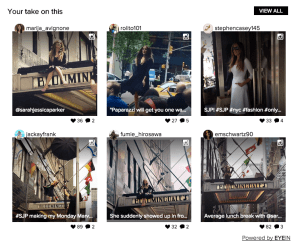Mobli, the photo- and video-based social network, launched in 2010, but it has just uncovered its flagship product, a real-time image search engine called EyeIn. Now available on the web and as a mobile app, EyeIn’s algorithms filter out content like selfies to return the most relevant results to users almost as soon as they are posted on social networks.
An embeddable plugin of EyeIn has also been piloted by six sites, including the Huffington Post and News Cult, and will use a revenue share model similar to Outbrain and Taboola.
The Tel Aviv-based startup, which has raised about $86 million in funding, was founded by chief executive officer Moshe Hogeg to create EyeIn, which has been in development for over three years.
“As a company, EyeIn is at the pinnacle and center of our focus,” says chief operating officer Ido Sadeh, who demonstrated the search engine for TechCrunch.
He states that Mobli doesn’t see Google Image Search or Instagram as direct competitors to EyeIn because each serves a different function.
EyeIn differentiates by selecting the most relevant content from live events or trending topics and sorting images so users don’t have to wade through thousands of hashtag results or rely on news outlets to select photos and videos.
“We have eyes all over the world. Everything worth seeing is being capture by someone with a smartphone. What we lack is a mechanism to collect those eyes, to enable us to look around,” says Sadeh.
“The other challenge is user-generated content that is not always relevant. For example, at a Lady Gaga concert, 70 percent of images are selfies, which are not the most relevant or interesting content that comes to mind. Our set of algorithms allows us to tune down the noise.”
How EyeIn Saves Your Eyeballs From Selfies
Some of the content returned by EyeIn comes from Mobli, but most is mined from Twitter, Facebook, and Instagram.
“When Instagram was purchased by Facebook, we were considered a little competitor of Instagram’s,” says Sadeh.
“It didn’t take us long to understand that Instagram is empowering our vision and we are really happy to have all these different databases that are location-rich and searchable.”
In order to understand context and predict what its users want to see, EyeIn uses a combination of image recognition technology; natural language processing to analyze information from titles, captions, and comments; and machine learning to improve search results over time.
The search engine also analyzes audio in videos. For example, at a sports game, EyeIn figures out when something important is happening by identifying peaks in noise level.
“Ninety minutes of a soccer game contains 80 minutes of boring content on the field and if it’s a good game, it will have 10 minutes of goals, arbitrage, cheerleading, and what have you,” says Sadeh.
“When it’s interesting to the crowd, we are able through analysis to upvote these pieces of content and deliver to anyone who watches through EyeIn a relevant experience.”
One of EyeIn’s most interesting features is the ability to filter image results by date. Sadeh demoed a search of Paris’ Place de la Republique, going back to the January 11 rally in support of Charlie Hebdo. Being able to narrow down search results by date will be a very useful tool for journalists, historians, archivist, and anyone else in need of a visual time machine.
EyeIn For Publishers
While EyeIn’s target user base is consumers, its program for partner sites is designed to help online companies increase user engagement and partake in ad revenue.

Unlike search results for EyeIn’s site and app, which is targeted to consumers, its plugin for publishers is limited to 32 images, which are based on an article’s content and updated in real-time.
For ongoing event like a sport game, EyeIn’s plugin may get readers to return to the same site by providing ongoing live coverage with very little work required by the publisher.
“We are able to provide in real-time a social album with a very wide perspective as things happen. That is from a content perspective,” says Sadeh.
“From a financial perspective, our pilots with six publication partners show an increase in time on site of around 50 percent and we know time on site equals higher CPM [cost per thousand impressions].”
